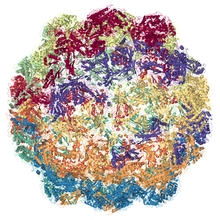Encapsulin
Appearance

The encapsulins are a family of bacterial proteins that serve as the main structural components of encapsulin nanocompartments.[1] There are several different encapsulin proteins, including EncA, which forms the shell, and EncB, EncC, and EncD, which form the core.[1]
References
- ^ a b McHugh, CA; Fontana, J; Nemecek, D; Cheng, N; Aksyuk, AA; Heymann, JB; Winkler, DC; Lam, AS; Wall, JS; Steven, AC; Hoiczyk, E (1 September 2014). "A virus capsid-like nanocompartment that stores iron and protects bacteria from oxidative stress". The EMBO Journal. 33 (17): 1896–911. doi:10.15252/embj.201488566. PMC 4195785. PMID 25024436.
